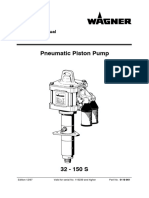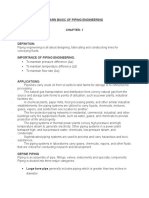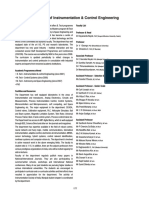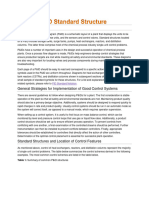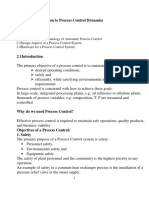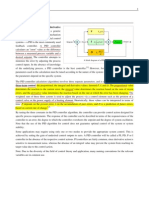Process Control Fundamentals
Uploaded by
Jude HarrisonProcess Control Fundamentals
Uploaded by
Jude HarrisonThe Importance of Process Control
The Importance of Process Control
Reducing variability can also save money by reducing the need for
Activities
product padding to meet required product specifications. Padding
refers to the process of making a product of higher-quality than it
needs to be to meet specifications. When there is variability in the end
product (i.e., when process control is poor), manufacturers are forced
to pad the product to ensure that specifications are met, which adds
to the cost. With accurate, dependable process control, the setpoint
(desired or optimal point) can be moved closer to the actual product
specification and thus save the manufacturer money.
3. What are the main reasons for
manufacturers to control a process?
Select all options that apply.
1
2
3
4
PV limit to ensure quality
PV limit to ensure quality
Reduce variability
Ensure safety
Reduce costs
Increase efficiency
Increase productivity
PV Setpoint
Low Variability
PV Setpoint
High Variability
Increase Efficiency
Some processes need to be maintained at a specific point to maximize
efficiency. For example, a control point might be the temperature at
which a chemical reaction takes place. Accurate control of temperature
ensures process efficiency. Manufacturers save money by minimizing
the resources required to produce the end product.
Ensure Safety
A run-away process, such as an out-of-control nuclear or chemical
reaction, may result if manufacturers do not maintain precise control
of all of the processg variables. The consequences of a run-away
process can be catastrophic.
Precise process control may also be required to ensure safety. For
example, maintaining proper boiler pressure by controlling the inflow
of air used in combustion and the outflow of exhaust gases is crucial
in preventing boiler implosions that can clearly threaten the safety of
workers.
COMPLETE WORKBOOK EXERCISE - THE IMPORTANCE OF PROCESS CONTROL
Fundamentals of Control
2006 PAControl.com
Control Theory Basics
This section presents some of the basic concepts of control and provides a foundation from which to
understand more complex control processes and algorithms later described in this module. Common terms and
concepts relating to process control are defined in this section.
LEARNING OBJECTIVES
After completing this section, you will be able to:
Define control loop
Describe the three tasks necessary for process control to occur:
Measure
Compare
Adjust
Define the following terms:
Process variable
Setpoint
Manipulated variable
Measured variable
Error
Offset
Load disturbance
Control algorithm
List at least five process variables that are commonly controlled in process measurement industries
At a high level, differentiate the following types of control:
Manual versus automatic feedback control
Closed-loop versus open-loop control
Note: To answer the activity questions the Hand Tool (H) should be activated.
Fundamentals of Control
2006 PAControl.com
Control Theory Basics
The Control Loop
Imagine you are sitting in a cabin in front of a small fire on a cold
winter evening. You feel uncomfortably cold, so you throw another
log on the fire. Thisis an example of a control loop. In the
control loop, a variable (temperature) fell below the setpoint (your
comfort level), and you took action to bring the process back into the
desired condition by adding fuel to the fire. The control loop will
now remain static until the temperature again rises above or falls
below your comfort level.
Activities
1. The three tasks associated with any
control loop are measurement,
comparison, and adjustment. Is this
statement true or false?
THREE TASKS
Control loops in the process control industry work in the same way,
requiring three tasks to occur:
Measurement
Comparison
Adjustment
In Figure 7.1, a level transmitter (LT) measures the level in the tank
and transmits a signal associated with the level reading to a controller
(LIC). The controller compares the reading to a predetermined value,
in this case, the maximum tank level established by the plant
operator, and finds that the values are equal. The controller then
sends a signal to the device that can bring the tank level back to a
lower levela valve at the bottom of the tank. The valve opens to let
some liquid out of the tank.
Many different instruments and devices may or may not be used in
control loops (e.g., transmitters, sensors, controllers, valves, pumps),
but the three tasks of measurement, comparison, and adjustment are
always present.
LIC
Maximum
level
LT
A Simple Control Loop
Fundamentals of Control
2006 PAControl.com.
Control Theory Basics
Process Control Terms
As in any field, process control has its own set of common terms that
you should be familiar with and that you will use when talking about
control technology.
PROCESS VARIABLE
A process variable is a condition of the process fluid (a liquid or gas)
that can change the manufacturing process in some way. In the
example of you sitting by the fire, the process variable was
temperature. In the example of the tank in Figure 7.1, the process
variable is level. Common process variables include:
Pressure
Flow
Level
Temperature
Density
Ph (acidity or alkalinity)
Liquid interface (the relative amounts of different liquids that are
combined in a vessel)
Mass
Conductivity
SETPOINT
The setpoint is a value for a process variable that is desired to be
maintained. For example, if a process temperature needs to kept
within 5 C of 100 C, then the setpoint is 100 C. A temperature
sensor can be used to help maintain the temperature at setpoint.
The sensor is inserted into the process, and a contoller compares the
temperature reading from the sensor to the setpoint. If the temperature
reading is 110 C, then the controller determines that the process is
above setpoint and signals the fuel valve of the burner to close slightly
until the process cools to 100 C. Set points can also be maximum or
minimum values. For example, level in tank cannot exceed 20 feet.
Activities
2. A process variable is a
condition that can change
the process in some way.
3. Imagine you are in a cabin in
front of a small fire on a cold
winter evening. You feel
uncomfortably cold, so you
throw another log into the fire.
In this scenario, the process
variable is temperature. Is this
true or false?
4. If the level of a liquid in a tank
must be maintained within 5 ft
of 50 ft, what is the liquids
setpoint?
1
2
3
4
Fundamentals of Control
2006 PAControl.com
45 ft
55 ft
5 ft
50 ft
Control Theory Basics
Process Control Terms
MEASURED VARIABLES, PROCESS VARIABLES, AND
MANIPULATED VARIABLES
In the temperature control loop example, the measured variable is
temperature, which must be held close to 100 C. In this example and
in most instances, the measured variable is also the process variable.
The measured variable is the condition of the process fluid that must
be kept at the designated setpoint.
Sometimes the measured variable is not the same as the process
variable. For example, a manufacturer may measure flow into and out
of a storage tank to determine tank level. In this scenario, flow is the
measured variable, and the process fluid level is the process variable.
The factor that is changed to keep the measured variable at setpoint is
called the manipulated variable. In the example described, the
manipulated variable would also be flow (Figure 7.2).
Setpoint
Process
variable or
measured
variable
Controller
Activities
5. ____________________ is a
sustained deviation of the process
variable from the setpoint.
6. A load disturbance is an undesired
change in one of the factors that can
affect the setpoint. Is this statement
true or false?
Manipulated
variable
Variables
ERROR
Error is the difference between the measured variable and the
setpoint and can be either positive or negative. In the temperature
control loop example, the error is the difference between the 110 C
measured variable and the 100 C setpointthat is, the error is +10
C.
The objective of any control scheme is to minimize or eliminate error.
Therefore, it is imperative that error be well understood. Any error
can be seen as having three major components. These three
components are shown in the figure on the folowing page
Magnitude
The magnitude of the error is simply the deviation between the values
of the setpoint and the process variable. The magnitude of error at any
point in time compared to the previous error provides the basis for
determining the change in error. The change in error is also an
important value.
Fundamentals of Control
2006 PAControl.com
Control Theory Basics
Process Control Terms
Duration
Duration refers to the length of time that an error condition has
existed.
Activities
Rate Of Change
The rate of change is shown by the slope of the error plot.
Rate of Change of Error
(Slope of Error Plot)
PV
Magnitude of Error
Duration
SP
Components of Error
OFFSET
Offset is a sustained deviation of the process variable from the
setpoint. In the temperature control loop example, if the control
system held the process fluid at 100.5 C consistently, even though
the setpoint is 100 C, then an offset of 0.5 C exists.
LOAD DISTURBANCE
A load disturbance is an undesired change in one of the factors that
can affect the process variable. In the temperature control loop
example, adding cold process fluid to the vessel would be a load
disturbance because it would lower the temperature of the process
fluid.
CONTROL ALGORITHM
A control algorithm is a mathematical expression of a control
function. Using the temperature control loop example, V in the
equation below is the fuel valve position, and e is the error. The
relationship in a control algorithm can be expressed as:
Fundamentals of Control
2006 PAControl.com
Control Theory Basics
Process Control Terms
Activities
V = f ( e)
The fuel valve position (V) is a function (f) of the sign (positive or
negative) of the error (Figure 7.3).
7. Automatic control systems are
control operations that involve
human action to make adjustment.
Is this statement true or false?
Summing
block
Process
variable
Error
f(e)
Manipulated
variable
Valve
position
Feedback
Algorithm Example
Control algorithms can be used to calculate the requirements of much
more complex control loops than the one described here. In more
complex control loops, questions such as How far should the valve
be opened or closed in response to a given change in setpoint? and
How long should the valve be held in the new position after the
process variable moves back toward setpoint? need to be answered.
MANUAL AND AUTOMATIC CONTROL
Before process automation, people, rather than machines, performed
many of the process control tasks. For example, a human operator
might have watched a level gauge and closed a valve when the level
reached the setpoint. Control operations that involve human
action to make an adjustment are called manual control systems.
Conversely, control operations in which no human intervention is
required, such as an automatic valve actuator that responds to a level
controller, are called automatic control systems.
Fundamentals of Control
2006 PAControl.com
Control Theory Basics
Process Control Terms
Activities
CLOSED AND OPEN CONTROL LOOPS
A closed control loop exists where a process variable is measured,
compared to a setpoint, and action is taken to correct any deviation
from setpoint. An open control loop exists where the process variable
is not compared, and action is taken not in response to
feedback on the condition of the process variable, but is instead taken
without regard to process variable conditions. For example, a water
valve may be opened to add cooling water to a process to prevent the
process fluid from getting too hot, based on a pre-set time interval,
regardless of the actual temperature of the process fluid.
8. Under what circumstances does
an open control loop exist?
Select all options that apply.
1
2
3
4
5
Process variable is not measured
Process variable is not compared
Process variable is measured
and compared to a setpoint
Action is taken without regard
to process variable conditions
Action is taken with regard
to process variable conditions
COMPLETE WORKBOOK EXERCISE - CONTROL THEORY BASICS
10
Fundamentals of Control
2006 PAControl.com
Components of Control Loops and ISA
Symbology
This section describes the instruments, technologies, and equipment used to develop and maintain process
control loops. In addition, this section describes how process control equipment is represented in technical
drawings of control loops.
LEARNING OBJECTIVES
After completing this section, you will be able to:
Describe the basic function of and, where appropriate, the basic method of operation for the following
control loop components:
Primary element/sensor
Transducer
Converter
Transmitter
Signal
Indicator
Recorder
Controller
Correcting element/final control element
Actuator
List examples of each type of control loop component listed above
State the advantages of 420 mA current signals when compared with other types of signals
List at least three types of final control elements, and for each one:
Provide a brief explanation of its method of operation
Describe its impact on the control loop
List common applications in which it is used
Given a piping and instrumentation drawing (P&ID), correctly label the:
Instrument symbols (e.g., control valves, pumps, transmitters)
Location symbols (e.g., local, panel-front)
Signal type symbols (e.g., pneumatic, electrical)
Accurately interpret instrument letter designations used on P&IDs
Fundamentals of Control
2006 PAControl.com
11
Components of Control Loops and ISA Symbology
Control Loop Equipment and Technology
The previous section described the basic elements of control as
Activities
measurement, comparison, and adjustment. In practice, there are
instruments and strategies to accomplish each of these essential
tasks. In some cases, a single process control instrument, such as a
modern pressure transmitter, may perform more than one of the basic
control functions. Other technologies have been developed so that
communication can occur among the components that measure,
compare, and adjust.
PRIMARY ELEMENTS/SENSORS
In all cases, some kind of instrument is measuring changes in the
process and reporting a process variable measurement. Some of the
greatest ingenuity in the process control field is apparent in sensing
devices. Because sensing devices are the first element in the control
loop to measure the process variable, they are also called primary
elements. Examples of primary elements include:
Pressure sensing diaphragms, strain gauges, capacitance cells
Resistance temperature detectors (RTDs)
Thermocouples
Orifice plates
Pitot tubes
Venturi tubes
Magnetic flow tubes
Coriolis flow tubes
Radar emitters and receivers
Ultrasonic emitters and receivers
Annubar flow elements
Vortex sheddar
1. Identify three examples of a primary
element/sensors in process control?
Select all options that apply.
1
2
3
4
5
Resistance Temperature Detectors
Thermocouples
Control Valve
Converter
Pitot tubes
2. Primary elements will not make direct
contact with the process fluid. Is this
statement true or false?
Primary elements are devices that cause some change in their
property with changes in process fluid conditions that can then be
measured. For example, when a conductive fluid passes through the
magnetic field in a magnetic flow tube, the fluid generates a voltage
that is directly proportional to the velocity of the process fluid. The
primary element (magnetic flow tube) outputs a voltage that can be
measured and used to calculate the fluids flow rate. With an RTD, as
the temperature of a process fluid surrounding the RTD rises or falls,
the electrical resistance of the RTD increases or decreases a
proportional amount. The resistance is measured, and from this
measurement, temperature is determined.
12
Fundamentals of Control
2006 PAControl.com
Components of Control Loops and ISA Symbology
Control Loop Equipment and Technology
TRANSDUCERS AND CONVERTERS
A transducer is a device that translates a mechanical signal into an
electrical signal. For example, inside a capacitance pressure device, a
transducer converts changes in pressure into a proportional change in
capacitance.
Activities
3. A ____________ is a device
that translates a mechanical signal
into an electrical signal.
A converter is a device that converts one type of signal into another
type of signal. For example, a converter may convert current into
voltage or an analog signal into a digital signal. In process control, a
converter used to convert a 420 mA current signal into a 315 psig
pneumatic signal (commonly used by valve actuators) is called a
current-to-pressure converter.
TRANSMITTERS
A transmitter is a device that converts a reading from a sensor
or transducer into a standard signal and transmits that signal
to a monitor or controller. Transmitter types include:
Pressure transmitters
Flow transmitters
Temperature transmitters
Level transmitters
Analytic (O2 [oxygen], CO [carbon monoxide], and pH)
transmitters
Fundamentals of Control
2006 PAControl.com
4. A transmitter is a device that converts
a reading from a transducer into a
standard signal and transmits that signal
to a monitor or controller. Is this
statement true or false?
13
Components of Control Loops and ISA Symbology
Control Loop Equipment and Technology
SIGNALS
Activities
There are three kinds of signals that exist for the process industry to
transmit the process variable measurement from the instrument to a
centralized control system.
1. Pneumatic signal
2. Analog signal
3. Digital signal
5. Identify the signal types that are
used in the process control
industry?
Select all options that apply.
1
2
Pneumatic Signals
Pneumatic signals are signals produced by changing the air pressure
in a signal pipe in proportion to the measured change in a process
variable. The common industry standard pneumatic signal range is
315 psig. The 3 corresponds to the lower range value (LRV) and the
15 corresponds to the upper range value (URV). Pneumatic signalling
is still common. However, since the advent of electronic instruments
in the 1960s, the lower costs involved in running electrical signal wire
through a plant as opposed to running pressurized air tubes has made
pneumatic signal technology less attractive.
3
4
5
Hydraulic signals
Digital signals
Analog signals
Pneumatic signals
Electro-magnetic signals
Analog Signals
The most common standard electrical signal is the 420 mA current
signal. With this signal, a transmitter sends a small current through a
set of wires. The current signal is a kind of gauge in which
4 mA represents the lowest possible measurement, or zero, and 20
mA represents the highest possible measurement.
For example, imagine a process that must be maintained at 100 C.
An RTD temperature sensor and transmitter are installed in the
process vessel, and the transmitter is set to produce a 4 mA signal
when the process temperature is at 95 C and a 20 mA signal
when the process temperature is at 105 C. The transmitter will
transmit a 12 mA signal when the temperature is at the 100 C
setpoint. As the sensors resistance property changes in
response to changes in temperature, the transmitter outputs a
420 mA signal that is proportionate to the temperature changes. This
signal can be converted to a temperature reading or an
input to a control device, such as a burner fuel valve.
Other common standard electrical signals include the 15 V (volts)
signal and the pulse output.
14
Fundamentals of Control
Components of Control Loops and ISA Symbology
Control Loop Equipment and Technology
Digital Signals
Activities
Digital signals are the most recent addition to process control signal
technology. Digital signals are discrete levels or values that are
combined in specific ways to represent process variables and also carry
other information, such as diagnostic information. The methodology
used to combine the digital signals is referred to as protocol.
Manufacturers may use either an open or a proprietary digital
protocol. Open protocols are those that anyone who is developing a
control device can use. Proprietary protocols are owned by specific
companies and may be used only with their permission. Open digital
protocols include the HART (highway addressable remote
transducer) protocol, FOUNDATION Fieldbus, Profibus, DeviceNet,
and the Modbus protocol.
6. The ___________ is a
human-readable device that
displays information about the
process or the instrument it is
connected to.
(See Module 8: Communication Technologies for more information
on digital communication protocols.)
INDICATORS
While most instruments are connected to a control system, operators
sometimes need to check a measurement on the factory floor at the
measurement point. An indictor makes this reading possible. An
indicator is a human-readable device that displays information about
the process. Indicators may be as simple as a pressure or temperature
gauge or more complex, such as a digital read-out device. Some
indicators simply display the measured variable, while others have
control buttons that enable operators to change settings in the field.
7. Which of the following are examples
of a digital signal?
Select all options that apply.
1
2
3
4
5
15
Profibus
4 - 20 mA
1-5v
Fieldbus
3 - 15 psig
Fundamentals of Control
2006 PAControl.com
Components of Control Loops and ISA Symbology
Control Loop Equipment and Technology
RECORDERS
Activities
A recorder is a device that records the output of a measurement
devices. Many process manufacturers are required by law to provide a
process history to regulatory agencies, and manufacturers use
recorders to help meet these regulatory requirements. In addition,
manufacturers often use recorders to gather data for trend analyses.
By recording the readings of critical measurement points and
comparing those readings over time with the results of the process,
the process can be improved.
8. A recorder is a device that records
the ________________ of a
measurement or control device.
Different recorders display the data they collect differently. Some
recorders list a set of readings and the times the readings were taken;
others create a chart or graph of the readings. Recorders that create
charts or graphs are called chart recorders.
CONTROLLERS
A controller is a device that receives data from a measurement
instrument, compares that data to a programmed setpoint, and, if
necessary, signals a control element to take corrective action.
Local controllers are usually one of the three types: pneumatic,
electronic or programmable. Contollers also commonly reside
in a digital control system.
Computer-based
central controller
Pneumatic, electronic, or
programmable local controller
DCS
Transmitter
Power
supply
Controller
(CPU)
Single-loop
controller
Valve
I/O card
Controllers
16
Fundamentals of Control
2006 PAControl.com
Components of Control Loops and ISA Symbology
Control Loop Equipment and Technology
Controllers may perform complex mathematical functions to compare
Activities
a set of data to setpoint or they may perform simple addition or
subtraction functions to make comparisons. Controllers always have
an ability to receive input, to perform a mathematical function with
the input, and to produce an output signal. Common examples of
controllers include:
Programmable logic controllers (PLCs)PLCs are usually
computers connected to a set of input/output (I/O) devices. The
computers are programmed to respond to inputs by sending
outputs to maintain all processes at setpoint.
Distributed control systems (DCSs)DCSs are controllers that,
in addition to performing control functions, provide readings of
the status of the process, maintain databases and advanced
man-machine-interface.
1
2
3
4
Actuators
Transmitters
Transducers
Controllers
10. Which of the following is the most
common final control element in
process control industries?
Setpoint
P
9. Which of the following have the
ability to receive input, to perform
a mathematical function with the
input, and produce an output signal?
Pipestand Controller
(Pneumatic or Electronic)
Single Loop Digital Converter
(Electronic)
Analog Rack Mount Controller
(Electronic)
1
2
3
4
Agitator
Pump motor
Valve
Louver
Distributed Control System
(Electronic)
Types of Process Controllers
Fundamentals of Control
2006 PAControl.com
17
Components of Control Loops and ISA Symbology
Control Loop Equipment and Technology
Activities
11. _______________ is a part
final control device that causes a
physical change in the final control
device when signaled to do so.
Smart
Transmitter
Digital Valve Controller
(Smart Positioner)
Smart Transmitter
(Provides PID Output)
Types of Process Controllers
CORRECTING ELEMENTS/FINAL CONTROL ELEMENTS
The correcting or final control element is the part of the control
system that acts to physically change the manipulated variable. In
most cases, the final control element is a valve used to restrict or cut
off fluid flow, but pump motors, louvers (typically used to regulate air
flow), solenoids, and other devices can also be final control elements.
Final control elements are typically used to increase or decrease fluid
flow. For example, a final control element may regulate the flow of
fuel to a burner to control temperature, the flow of a catalyst into a
reactor to control a chemical reaction, or the flow of air into a boiler
to control boiler combustion.
In any control loop, the speed with which a final control element
reacts to correct a variable that is out of setpoint is very important.
Many of the technological improvements in final control elements are
related to improving their response time.
ACTUATORS
An actuator is the part of a final control device that causes a physical
change in the final control device when signalled to do so. The most
common example of an actuator is a valve actuator, which opens or
closes a valve in response to control signals from a controller.
Actuators are often powered pneumatically, hydraulically, or
electrically. Diaphragms, bellows, springs, gears, hydraulic pilot
valves, pistons, or electric motors are often parts of an actuator system.
18
Fundamentals of Control
2006 PAControl.com
Components of Control Loops and ISA Symbology
ISA Symbology
The Instrumentation, Systems, and Automation Society (ISA) is one of
the leading process control trade and standards organizations. The ISA
has developed a set of symbols for use in engineering drawings and
designs of control loops (ISA S5.1 instrumentation symbol
specification). You should be familiar with ISA symbology so that you
can demonstrate possible process control loop solutions on paper to
your customer. Figure 7.5 shows a control loop using ISA symbology.
Drawings of this kind are known as piping and instrumentation
drawings (P&ID).
Activities
12. What does the acronym P&ID
stand for?
1
2
3
FIC
123
SP
TIC
123
TY
123
Piping and Instrument Designing
Piping and Instrumentation
Drawing
Process Control and Installation
Drawing
Proportional, Intergral and
Derivative control
YIC
123
FT
123
TT
123
Piping and Instrumentation Drawing
(P&ID)
Fundamentals of Control
2006 PAControl.com
19
Components of Control Loops and ISA Symbology
ISA Symbology
Activities
SYMBOLS
In a P&ID, a circle represents individual measurement instruments,
such as transmitters, sensors, and detectors (Figure 7.6).
LOCATION
13. Which of the following is a symbol of
a transmitter in an auxiliary
location?
1
Control Room
Auxiliary
Field
Not Accessible
Figure 7.6: Discrete Instruments
A single horizontal line running across the center of the shape
indicates that the instrument or function is located in a primary
location (e.g., a control room). A double line indicates that the
function is in an auxiliary location (e.g., an instrument rack). The
absence of a line indicates that the function is field mounted, and a
dotted line indicates that the function or instrument is inaccessible
(e.g., located behind a panel board).
A square with a circle inside represents instruments that both display
measurement readings and perform some control function
(Figure 7.7). Many modern transmitters are equipped with
microprocessors that perform control calculations and send control
output signals to final control elements.
DISPLAY AND CONTROL TYPES
14. Which of the following is a symbol of
a field-mounted control/display
element?
Control Room
Field
Not Accessible
Flow/
Square
Root
Shared Control/Display Elements
A hexagon represents computer functions, such as those carried out
by a controller (Figure 7.8).
Control Types
4
Control Room
Auxiliary
Field
Not Accessible
Computer Functions (Controllers)
20
Fundamentals of Control
2006 PAControl.com
Components of Control Loops and ISA Symbology
ISA Symbology
Activities
15. Which of the following is a symbol of
a controller located behind a
panel?
Fundamentals of Control
2006 PAControl.com
21
Components of Control Loops and ISA Symbology
ISA Symbology
Activities
A square with a diamond inside represents PLCs (Figure 7.9).
PLC Types
16. The symbol displayed below denotes
a PLC in a primary location.
Is this statement true or false?
Control Room
Auxiliary
Field
Not accessible
PLCs
Two triangles with their apexes contacting each other (a bow tie
shape) represent a valve in the piping. An actuator is always drawn
above the valve (Figure 7.10).
Pneumatic valve
Manual valve
Electric valve
17. Which of the following is a symbol
of a pneumatic valve?
Valves
Pumps
Directional arrows showing the flow direction represent a pump
(Figure 7.11).
Pumps
Fundamentals of Control
2006 PAControl.com
22
Components of Control Loops and ISA Symbology
ISA Symbology
Piping and Connections
Piping and connections are represented with several different symbols
(Figure 7.12):
A heavy solid line represents piping
A thin solid line represents process connections to instruments
(e.g., impulse piping)
A dashed line represents electrical signals (e.g., 420 mA
connections)
A slashed line represents pneumatic signal tubes
A line with circles on it represents data links
Activities
18. The symbols displayed below represent
a data link and a process connection.
Is this statement true or false?
Other connection symbols include capillary tubing for filled systems
(e.g., remote diaphragm seals), hydraulic signal lines, and guided
electromagnetic or sonic signals.
Piping
Process
connection
Electrical
signal
Pneumatic
signal
Data
link
Capillary tubing for
filled systems
Hydraulic
signal line
Guided
electromagnetic
or sonic signal
Piping and Connection Symbols
23
Fundamentals of Control
2006 PAControl.com
Components of Control Loops and ISA Symbology
ISA Symbology
Activities
IDENTIFICATION LETTERS
Identification letters on the ISA symbols (e.g., TT for temperature
transmitter) indicate:
The variable being measured (e.g., flow, pressure, temperature)
The devices function (e.g., transmitter, switch, valve, sensor,
indicator)
Some modifiers (e.g., high, low, multifunction)
19. The initial letter on an ISA symbol
indicates the measured variable. Is
this statement true or false?
Table 7.1 on page 26 shows the ISA identification letter designations.
The initial letter indicates the measured variable. The second letter
indicates a modifier, readout, or device function. The third letter
usually indicates either a device function or a modifier.
For example, FIC on an instrument tag represents a flow indicating
controller. PT represents a pressure transmitter. You can find
identification letter symbology information on the ISA Web site at
http://www.isa.org.
20. What does the third letter on an ISA
symbol indicate?
TAG NUMBERS
Numbers on P&ID symbols represent instrument tag numbers. Often
these numbers are associated with a particular control loop (e.g., flow
transmitter 123). See Figure 7.13.
FIC
123
Identification
letters
1
2
3
4
Device function or a modifier
Measured variable
Readout
Type of process fluid
Tag number
Identification Letters and Tag Number
Fundamentals of Control
2006 PAControl.com
24
You might also like
- Feed Forward and Cascade Control Experiment100% (1)Feed Forward and Cascade Control Experiment28 pages
- Aga4372 Asc-10 Sprayer Operators Manual Revision 2.5No ratings yetAga4372 Asc-10 Sprayer Operators Manual Revision 2.594 pages
- Process Control: WWW - Control-Systems-Principles - Co.uk. CE117 Process ControlNo ratings yetProcess Control: WWW - Control-Systems-Principles - Co.uk. CE117 Process Control6 pages
- 4-20 MA Process Control Loops - DCS Control Loop - Inst ToolsNo ratings yet4-20 MA Process Control Loops - DCS Control Loop - Inst Tools8 pages
- CO - Instrumentation & Control MIT, MANIPALNo ratings yetCO - Instrumentation & Control MIT, MANIPAL16 pages
- Instrument Technician Questions and AnswersNo ratings yetInstrument Technician Questions and Answers4 pages
- Process Control - Instrumentation and Control Engineering Interview QuestionsNo ratings yetProcess Control - Instrumentation and Control Engineering Interview Questions11 pages
- Basic Instrumentation Measuring Devices and Basic Pid ControlNo ratings yetBasic Instrumentation Measuring Devices and Basic Pid Control125 pages
- Rocess: Process As Used in The Terms Process Control and Process IndustryNo ratings yetRocess: Process As Used in The Terms Process Control and Process Industry8 pages
- Introduction To Process Automation - Process Control100% (1)Introduction To Process Automation - Process Control46 pages
- Chapter - 6: Instrumentation & Process Control in The ProcessNo ratings yetChapter - 6: Instrumentation & Process Control in The Process10 pages
- Basic Elements of Generalized Process ControlNo ratings yetBasic Elements of Generalized Process Control11 pages
- Instrumentation & Process Control Fundamentals: Designed By: Hossam A. HassaneinNo ratings yetInstrumentation & Process Control Fundamentals: Designed By: Hossam A. Hassanein39 pages
- Topic 2.0 Introduction To Process Control DynamicsNo ratings yetTopic 2.0 Introduction To Process Control Dynamics16 pages
- Datta Meghe College of Engineering, AiroliNo ratings yetDatta Meghe College of Engineering, Airoli39 pages
- In Amenas Gas Project Algeria: P03 10/12/03 Issued For Purchase J Neely J Pile J Pile R WalkerNo ratings yetIn Amenas Gas Project Algeria: P03 10/12/03 Issued For Purchase J Neely J Pile J Pile R Walker2 pages
- 4a Bulk Water Meter Installation in Chamber DrawingPEWSTDAMI004 PDF0% (1)4a Bulk Water Meter Installation in Chamber DrawingPEWSTDAMI004 PDF1 page
- Water Softeners Residential 5600 Valve Softeners US ManualNo ratings yetWater Softeners Residential 5600 Valve Softeners US Manual12 pages
- Freon ™ MO59 (R-417A) Refrigerant: Safety Data SheetNo ratings yetFreon ™ MO59 (R-417A) Refrigerant: Safety Data Sheet16 pages
- Validation of Inlet Gas Metering InstrumentationNo ratings yetValidation of Inlet Gas Metering Instrumentation13 pages
- Aga4372 Asc-10 Sprayer Operators Manual Revision 2.5Aga4372 Asc-10 Sprayer Operators Manual Revision 2.5
- Process Control: WWW - Control-Systems-Principles - Co.uk. CE117 Process ControlProcess Control: WWW - Control-Systems-Principles - Co.uk. CE117 Process Control
- 4-20 MA Process Control Loops - DCS Control Loop - Inst Tools4-20 MA Process Control Loops - DCS Control Loop - Inst Tools
- Process Control - Instrumentation and Control Engineering Interview QuestionsProcess Control - Instrumentation and Control Engineering Interview Questions
- Basic Instrumentation Measuring Devices and Basic Pid ControlBasic Instrumentation Measuring Devices and Basic Pid Control
- Rocess: Process As Used in The Terms Process Control and Process IndustryRocess: Process As Used in The Terms Process Control and Process Industry
- Introduction To Process Automation - Process ControlIntroduction To Process Automation - Process Control
- Chapter - 6: Instrumentation & Process Control in The ProcessChapter - 6: Instrumentation & Process Control in The Process
- Instrumentation & Process Control Fundamentals: Designed By: Hossam A. HassaneinInstrumentation & Process Control Fundamentals: Designed By: Hossam A. Hassanein
- Topic 2.0 Introduction To Process Control DynamicsTopic 2.0 Introduction To Process Control Dynamics
- In Amenas Gas Project Algeria: P03 10/12/03 Issued For Purchase J Neely J Pile J Pile R WalkerIn Amenas Gas Project Algeria: P03 10/12/03 Issued For Purchase J Neely J Pile J Pile R Walker
- 4a Bulk Water Meter Installation in Chamber DrawingPEWSTDAMI004 PDF4a Bulk Water Meter Installation in Chamber DrawingPEWSTDAMI004 PDF
- Water Softeners Residential 5600 Valve Softeners US ManualWater Softeners Residential 5600 Valve Softeners US Manual
- Freon ™ MO59 (R-417A) Refrigerant: Safety Data SheetFreon ™ MO59 (R-417A) Refrigerant: Safety Data Sheet

